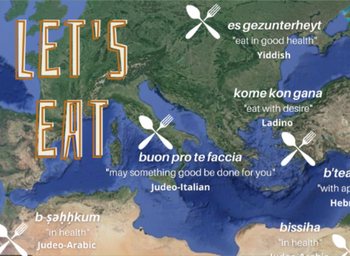Beyond B’Teavon: How to Say “Let’s Eat” in 10 Different Languages
Published Feb 27, 2023

Beyond B'Teavon: How to say "let's eat" in 10 different languages

On this map, we can see some of the many ways that Jews around the world welcome a meal. Some begin by commenting on their appetites, like in Ladino and Hebrew, while others bless all that may come after the meal— especially their health— such as in Judeo-Arabic, Judeo-Italian, and Yiddish. Of course, these expressions were generally accompanied by Hebrew blessings, which diverse Jewish communities shared. However, in each place they have lived, the bulk of the local Jewish language has been similar to the non-Jewish language surrounding the community or the language spoken in a previous location. While some Hebrew words are used by many Jewish communities, the pre-meal expressions borrow from the surrounding society rather than from our common ancient texts. These expressions also show patterns of influence among various languages: Hulaula’s gyana basima/ta borrows from Kurdish, one of several contact languages in the Kurdish region of Iran. Israeli Hebrew’s b’teavon finds its origins in a Yiddish phrase that’s not pictured, mit a gutn apetit (with a good appetite), because Yiddish was the native language of many early Modern Hebrew speakers. Overall, these expressions demonstrate the diversity of Jewish languages and their multiple sources of influence.
This exhibit highlights the unique ways in which Jewish diners engage with the food, guests, and those who prepared the meal. The map serves as a reminder of the diversity of the Jewish people, not only in the foods they’re about to eat, but also in their language. Some cultures focus on the goodness of the food, others highlight health and wellness, while still others emphasize the pleasantness of the company. There are many differences among Jewish communities around the world, but there are also similarities. Unity is apparent in the mere existence of these expressions of gratitude the world over, which is visible even in classic Textual Hebrew statements such as mah rabu and hinei mah tov. This theme of simultaneous unity and diversity is ubiquitous across Judaism and Jewish culture globally, and there is no more apt vehicle for playing with these values than what brings all humans together: the enjoyment of food.
The HUC-JIR Jewish Language Project promotes research on, awareness about, and engagement surrounding the many languages spoken and written by Jews throughout history and around the world, from Ladino and Yiddish to Judeo-Arabic and Judeo-Malayalam.
Reflections
For foodies:
What sort of relationships do these blessings cultivate between diners and food?
For poets:
What might be the implications of “may whatever you’re eating be food” when not taken literally?
For language lovers:
Why might three different varieties of Judeo-Arabic across North Africa and the Middle East have different words for essentially the same blessing?
Want more?
Get curated JewishArts.org content in your inbox


